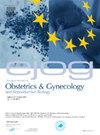Unveiling the advantages of laparoscopic myomectomy: A comprehensive systematic review and meta-analysis of outcomes and complications compared with traditional open surgery
IF 2.1
4区 医学
Q2 OBSTETRICS & GYNECOLOGY
European journal of obstetrics, gynecology, and reproductive biology
Pub Date : 2024-10-28
DOI:10.1016/j.ejogrb.2024.10.038
引用次数: 0
Abstract
Aims
To compare the outcomes of laparoscopic myomectomy (LM) and open myomectomy (OM) by reviewing the frequency, type and severity of complications reported by the Clavien–Dindo classification. In addition, this study evaluated differences in blood loss, length of operative time and hospital stay between these two surgical approaches.
Methods
A systematic search of electronic databases was conducted from their inception to January 2024 to identify studies comparing LM and OM with detailed surgical complications reported. The random effect model was applied, and the odds ratio was used for the main outcomes, with effect sizes presented alongside 95 % confidence intervals (CI). A p-value < 0.05 was considered to indicate significance.
Results
Of 296 studies identified, nine studies (total 224 patients) were included. LM was found to be associated with significantly lower rates of overall postoperative complications compared with OM. With no statistical heterogeneity between the studies (I2 = 0 %), the overall effect size was 0.67 (95 % CI 0.45–0.99), indicating a significant association between postoperative complications and open surgery (p = 0.04). Regarding Clavien–Dindo complications >grade 3, the overall effect size was 1.55 (95 % CI 0.47–5.08), indicating a non-significant association between grade 3 complications and surgical approach (p = 0.47). Despite superimposable operative time (effect size 1.40, 95 % CI 0.70–2.79; p = 0.342), LM showed significantly lower mean blood loss compared with OM, with an overall effect size of 0.34 (95 % CI 0.12–1.00; p = 0.049). The duration of hospital stay was significantly shorter in the LM group (2.0 vs 3.1 days), with an overall effect size of 0.09 (95 % CI 0.05–0.18), strongly associating the laparoscopic approach with reduced hospitalization stay (p < 0.001).
Conclusion
LM offers favourable outcomes compared with OM for the treatment of uterine myomas. Despite a slightly longer operative time, LM was found to be associated with lower rates of postoperative complications and reduced hospital stay. These findings support the preference for LM for the treatment of uterine myomas, highlighting its potential to improve patient outcomes and recovery.
揭示腹腔镜子宫肌瘤切除术的优势:与传统开腹手术相比,腹腔镜子宫肌瘤剔除术的疗效和并发症的全面系统回顾和荟萃分析。
目的:通过回顾克拉维恩-丁多分类法所报告的并发症发生频率、类型和严重程度,比较腹腔镜子宫肌瘤剔除术(LM)和开腹子宫肌瘤剔除术(OM)的疗效。此外,该研究还评估了这两种手术方法在失血量、手术时间和住院时间上的差异:方法:我们对电子数据库进行了系统性检索,检索时间从开始检索到 2024 年 1 月,目的是找出有详细手术并发症报告的 LM 和 OM 比较研究。采用随机效应模型,主要结果采用几率比,效应大小与 95% 置信区间 (CI) 同时显示。P 值 结果:在确定的 296 项研究中,纳入了 9 项研究(共 224 名患者)。研究发现,与 OM 相比,LM 的术后并发症发生率明显较低。各研究之间无统计学异质性(I2 = 0 %),总效应大小为 0.67(95 % CI 0.45-0.99),表明术后并发症与开放手术有显著相关性(p = 0.04)。至于 Clavien-Dindo 并发症 > 3 级,总效应大小为 1.55 (95 % CI 0.47-5.08),表明 3 级并发症与手术方式之间的关系不显著(p = 0.47)。尽管叠加了手术时间(效应大小为 1.40,95 % CI 0.70-2.79;p = 0.342),但 LM 的平均失血量明显低于 OM,总体效应大小为 0.34(95 % CI 0.12-1.00;p = 0.049)。腹腔镜手术组的住院时间明显更短(2.0 对 3.1 天),总效应大小为 0.09(95 % CI 0.05-0.18),这与腹腔镜手术缩短住院时间密切相关(P 结论:腹腔镜手术与其他手术相比,具有更佳的疗效:在子宫肌瘤的治疗中,腹腔镜手术的疗效优于腹腔镜手术。尽管腹腔镜手术时间稍长,但术后并发症发生率较低,住院时间缩短。这些研究结果支持首选 LM 治疗子宫肌瘤,突出了其改善患者预后和康复的潜力。
本文章由计算机程序翻译,如有差异,请以英文原文为准。
求助全文
约1分钟内获得全文
求助全文
来源期刊
CiteScore
4.60
自引率
3.80%
发文量
898
审稿时长
8.3 weeks
期刊介绍:
The European Journal of Obstetrics & Gynecology and Reproductive Biology is the leading general clinical journal covering the continent. It publishes peer reviewed original research articles, as well as a wide range of news, book reviews, biographical, historical and educational articles and a lively correspondence section. Fields covered include obstetrics, prenatal diagnosis, maternal-fetal medicine, perinatology, general gynecology, gynecologic oncology, uro-gynecology, reproductive medicine, infertility, reproductive endocrinology, sexual medicine and reproductive ethics. The European Journal of Obstetrics & Gynecology and Reproductive Biology provides a forum for scientific and clinical professional communication in obstetrics and gynecology throughout Europe and the world.

 求助内容:
求助内容: 应助结果提醒方式:
应助结果提醒方式:


